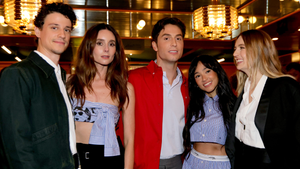Fringe actress Jasika Nicole never imagined that her upbringing—as a biracial lesbian from the South—would perfectly prepare her for a career in sci-fi TV.
“I was 23 the first time I was surrounded by a lot of people who looked like me,” says Jasika Nicole. That’s when she moved to New York City to pursue an acting career. Growing up biracial in Homewood, Ala., a suburb of Birmingham, Nicole says she often felt like a curiosity, the subject of whispers, an outsider. “There’s a lot of history in Birmingham, and so many important things have happened there, but it’s still an incredibly segregated city. It’s a really tricky place to grow up when you’re trying to figure out who you are, and people either want you to be one thing or another.”
Nicole lived with her mother in a predominantly white neighborhood and visited her father in a mostly black neighborhood. “It was important for me to either act as white as I could in some areas or act as black as I could in other areas—you know, whatever acting white or black really means.” Sometimes it meant literally stepping into different shoes. “I would wear Keds when I was at my mom’s house. I would wear K-Swiss when I was at my dad’s house. I thought that was the only way to fit in, because that’s all you really want to do when you’re growing up.”
Though she’s been openly lesbian for as long as she’s been dating women (since 2005, when she was filming the dance-themed movie Take the Lead, starring Antonio Banderas), grappling with her sexual identity as a young woman was problematic. “I had to be 13 or 14 years old, and I was in my room, and I was thinking, ‘There’s a very strong possibility I’m gay, but there’s no way I could be biracial and gay.’ I just knew I wasn’t strong enough to be able to carry both of those things in Birmingham, and so I just—I didn’t think about it.”
Moving to New York after college in North Carolina was an eye-opening experience for Nicole. She endured the slings and arrows of looking for work (“I probably went through about 500 auditions”), starred in commercials for McDonald’s and Alltel, and lost the lead role in Sam Mendes’s film Away We Go to Maya Rudolph. (She documents many of her true-life tales inHigh Yella Magic, her online comic book on Jasika Nicole.com.) In the city, for the first time Nicole suddenly saw a lot of other biracial people. And for the first time she addressed the feelings for women she’d suppressed in Birmingham. Five years ago she called her mother to say she was planning to go on a date with a woman. “She laughed and she was super excited for me,” Nicole says.
The next year Nicole called her father to say she would be visiting Alabama with her then-new girlfriend, Claire, a social worker. But he took the news badly, and father and daughter didn’t speak for nine months. “It was really crappy because I’ve always been Daddy’s girl,” she says. They’ve since reconciled, and her father has welcomed Claire (with whom Nicole lives in New York and Vancouver, Canada, where Fringe is taped) and apologized for each day they didn’t speak. But Nicole empathizes with his initial reticence. “It’s not something that is necessarily talked about a lot in the African-American community,” she says. “I can’t take away years of growing up thinking that homosexuality is wrong. That’s not something I could do single-handedly.”
More on next page...
\\\
(continued)
Growing up in Birmingham, she couldn’t have imagined that going back and forth between two seemingly disparate worlds would so eerily presage her professional life on J.J. Abrams’s sci-fi seriesFringe, where she plays FBI junior special agent Astrid Farnsworth and Astrid’s doppelgänger in an alternate universe.
But leading parallel lives prior to playing parallel roles was just the tip of the coincidence iceberg. Astrid’s counterpart has Asperger’s syndrome, a disorder on the autism spectrum. “The writers did not know about my sister when they wrote Astrid’s character,” she says. Nicole’s 12-year-old sister, Sedric, is autistic, though she’s lower-functioning than the alternate Astrid character. With such a close connection to the disorder, Nicole has carefully attempted to be realistic and to avoid stereotypes, sensitively drawing on her experiences with Sedric and her friends. “With television shows you have to do certain things to communicate to the audience,” she says. “You don’t want to overdo it, and you don’t want to be offensive about it. I’ve been with her for 12 years, so I know her pretty well.”
Nicole, 30, now occupies a rarefied position. She’s the only openly lesbian actress of color currently on a prime-time television series. But Nicole is nonchalant about it and doesn’t speculate much on what might have been had she not been out prior to Fringe. “Maybe it would be different then,” she says. “I can’t really say for sure.”
It’s difficult to gauge whether being out might affect her career the same way it might for another actress. Nicole is neither butch nor androgynous; she doesn’t read as gay on screen. But that’s all moot for Nicole. She simply can’t imagine not being herself.
“I just wasn’t raised to ever be not proud of who I was, whether it was because of my skin color or who my parents are or how much money I had or didn’t have,” she says. “My mom had to knock that into my head because we lived in a city where it was really easy to judge yourself by other people’s standards.”
Be SheWired's Friend on MySpace!





















































































 Cindy Ord/Getty Images
Cindy Ord/Getty Images

























